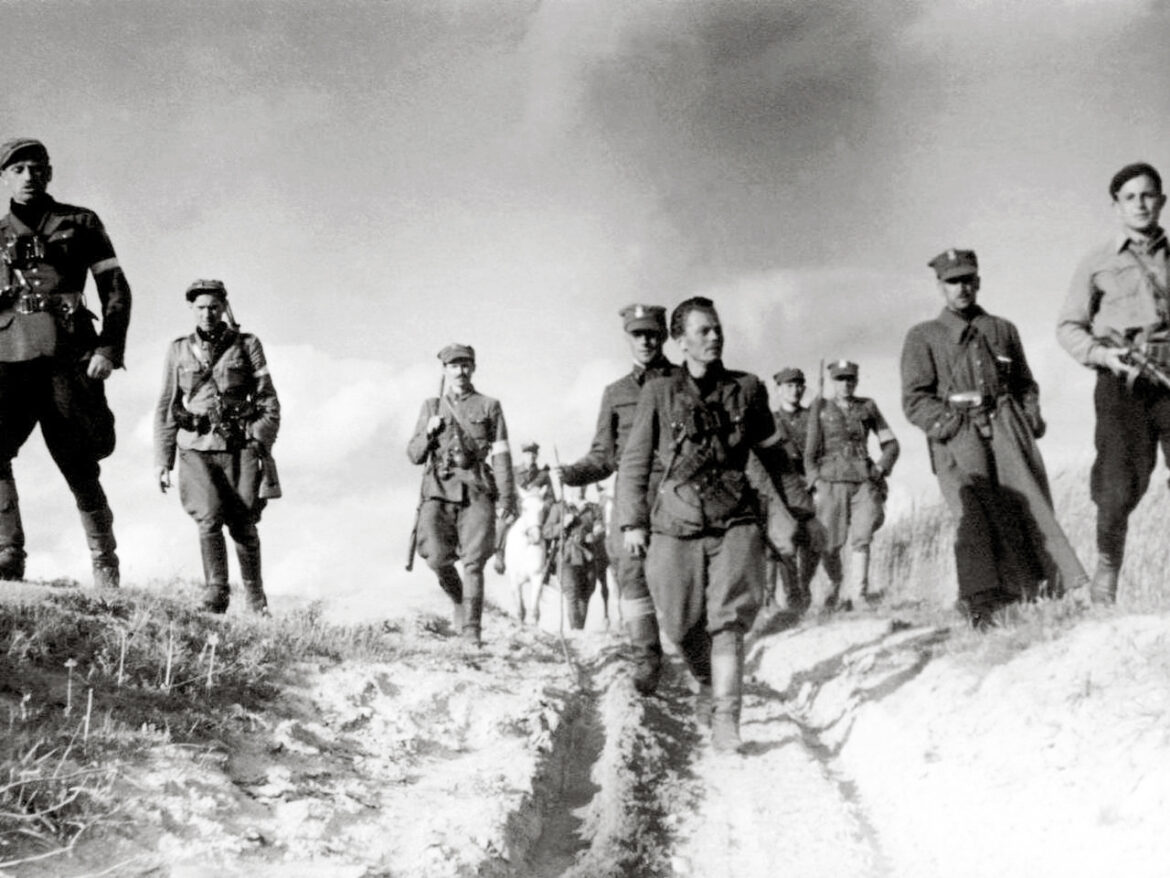In the Second Republic of Poland, Lake Naroch was the largest body of water of its kind, known as the “borderland sea”, where there was a great sailing and canoeing centre. During World War II, it witnessed the murder of Polish partisans’ squad by the Soviets and the NKVD.
One of the first partisan detachments of the Home Army, which began to be successful in the Vilnius region and gained popularity among the inhabitants, was the unit of Lieutenant Antoni Burzyński a.k.a. “Nurmo”, “Kmicic”. It was formed in 1943, initially consisting of volunteers and members of the underground nets of Postawa and Vishnev poviats. It grew to about 300 people.
Who was Burzynski before the war? In the 1930s, he graduated from the Divisional Infantry Reserve Cadet Course of the 5th Legion Infantry Regiment, holding the rank of reserve cadet and platoon sergeant with baccalaureate. He then enrolled at the Higher School of Political Science at the Eastern European Research Institute in Vilnius, from which he graduated in 1939. He was a very intelligent person – he knew many languages, including Turkish. At university he was promoted to second lieutenant. Until the outbreak of war, he worked in the military cell of the Vilnius Regional Railway Directorate. He dreamed of working in diplomacy.
“Kmicic men” were stationed at a permanent base during the Second World War. It was a wooded area, criss-crossed by strips of moorland that stretched between the Naroch and Blado lakes. The base consisted of two parts (‘A’ and ‘B’) a kilometre apart. The first was designed for a summer stay, the second for a winter camp. In winter, the partisans moved from huts to dugouts. The location of the base was agreed with the command of the Soviet partisan squad, which was stationed about 3 km away.
Makarov3, contacts with the Soviet side intensified – the Soviets, including Colonel Fyodor Makarov, visited the Polish encampment. During the feast, the idea of a joint Soviet-Polish action against the Germans was conceived. The target was the German garrison in Novy Miadziol, 10 km away. In preparation for the joint action, “Kmicic”‘s task was to report with his staff to the Soviet base to work out a detailed plan of attack together.
On the morning of 26 August 1943, the Polish group came to the Soviets in accordance with the agreement. It was greeted by members of the Voroshilov Brigade. They quickly bent over the plans. however, after a while Burzynski and his men heard the clang of reloading weapons and the cry – “Ruki v vierkh!” (Hands up!).
After being restrained, the arrested were locked in a dugout. From there they were led to interrogations, which were conducted by experienced NKVD officers. At the same time, the attack on the AK base began. It was possible to quickly disarm the surprised “Kmicic men”. About 200 people were taken prisoner. Then a special group of NKVD state security lieutenant Viktor Ber became active. It began interrogating Poles one by one, murdering those selected with a shot to the back of the head outside the camp. This was the fate of officers who were recognised by their alleged leadership qualities. About 80 partisans were killed in this way. The NKDW officers originated from Minsk. They were responsible for the deaths of thousands of Poles, as well as Russians, Belarusians, and Lithuanians. A document confirming the murder has survived from this action. It was written by Makarov. In the 1990s, documents on the case were discovered by Belarusian historians, who found a resolution of the Central Committee of the Central Committee of the Communist Party of Belarus of 22 June 1943, to which was attached an order to combat non-Soviet partisan units and “nationalist groups” by all means.
A particularly tragic fate befell ‘Kmicic’ himself, who was subjected to hours of torture to extract information from him about the AK underground network. The Polish hero died after many hours of torment. The torturers buried his body under a pine tree, having previously hung his corpse head down.
The Communists formed a “Bartosz Głowacki” squad from the surviving men of “Kmicic”, propagandistically subordinate to the Union of Polish Patriots in Moscow. The command was assigned to Wincenty Mroczkowski, a non-commissioned officer in the 19th Light Artillery Regiment from Novaya Vileyka, who had been expelled from the army before the war for communist propaganda. He adopted the conspiratorial pseudonym ‘Zapora’, parading in an officer’s uniform with an eagle without a crown on his cap.
When Mroczkowski’s unit left for the field, a reprisal action was launched against him by members of that squad who had not given him up for treason. He died shot in pursuit. From then on, the “Kmicic men” began a wider retaliatory action. The Soviets tried to capture the fugitives but were prevented by a German manhunt. In their analyses, they admitted that they had made a mistake with the Glowacki unit, assuming that the Poles had succumbed to rapid Sovietisation. The chief of the central staff of the Partisan Movement, Pantalejmon Ponomarenko, wrote that: “The transfer of 70 men to Mroczkowski’s unit was a mistake. It was not decided to execute them so that the Germans and Poles would not use it in the press as a second Katyn”.
As Leszek Kania wrote, the orphaned partisans wandering through the wilderness of the Vilnius region, “one starry night on the trail they met the long shadow of a man wearing a four- cornered cap”. This was Second Lieutenant Zygmunt Szendzielarz “Łupaszka” – commander of the 5th Wileńska “Death” Brigade.
Fyodor Makarov was awarded the title of “Hero of the USSR” as a reward for his “achievement”. He became a highly ranked communist activist in the party hierarchy and even became a deputy to the supreme council of the Belarusian SSR. After his death, a monument with his bust was erected in Molodechno, and streets in several villages around Lake Naroch began to bear his name.





